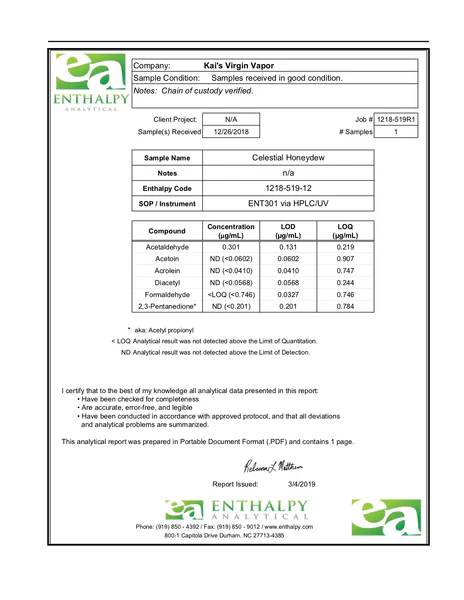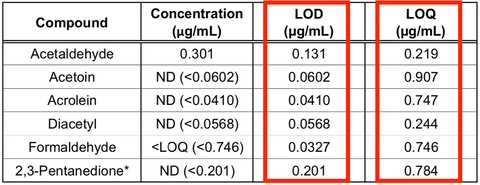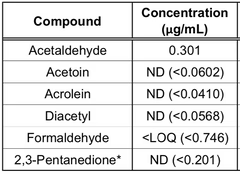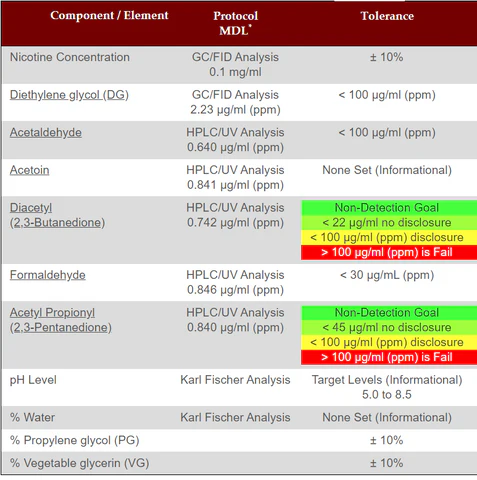Currently Empty: $0.00
How to Read a Vape Juice Lab Report
- Home
- How to Read a Vape Juice Lab Report
Our vape juice is phenomenally pure and our third party lab tests prove it! We’re also one of only a hand full of vape juice manufacturers who not only regularly test our products but also make those tests publicly available and easily accessible to our customers. We’re incredibly proud of our test results and we want to make sure you can appreciate them, too.
Looking at a professional lab report documenting vape juice analytical testing can be baffling for the lay person. We know because it was a steep learning curve for us, too!
We’ll walk you through it, step by step, so you understand exactly what you are looking at and what it means. You’ll also be prepared so that you can understand lab results from other manufacturers as well.
Let’s start by taking a look at the test results for our flavor Celestial Honeydew:

Always Look for Independent Lab Testing
When reviewing vape juice lab tests, the first thing you want to look at is where the test results come from. It is important to make sure the testing was done by a third party, independent lab that has no financial interest in the outcome.
Second, always make sure that the laboratory has experience specific to vape juice analysis. There are particular issues that come into play which make standard lab experience insufficient to reliably test e-juice.
As you can see, we use Enthalpy Analytics based in Durham, North Carolina. We chose Enthalpy because:
- Enthalpy has been a leader in the field of complex analytical measurement since 1993
- Enthalpy is the partner lab used by the American E-liquid Manufacturing Standards Association to develop standardized testing protocols and analytical criteria for the testing of e-juice
- Enthalpy is the lab chosen by the Electronic Cigarette Trade Association of Canada for their own lab testing
- Enthalpy is accredited by the National Environmental Laboratory Accreditation Program, the U.S. Department of Defense, the U.S. Army Corps of Engineers and the American Association for Laboratory Accreditation
- Enthalpy’s Technical Director, Gene Gillman, Ph.D., is a subject matter expert on e-juice testing. Dr. Gillman coauthored the study, “Evaluation of electronic cigarette liquids and aerosol for the presence of selected inhalation toxins,” along with the well known electronic cigarette researcher, Dr. Konstantinos Farsalinos
For all of these reasons, we have great confidence in the test results we receive from Enthalpy. We feel their credentials speak for themselves and can give that same confidence to our customers.

You will also see the note, “Chain of custody verified” on our lab reports. This is a certification from our lab that the samples they received from us followed the correct protocol for laboratory testing. This ensures the samples were properly handled at all points along the way through the testing procedure and that handling was documented and verified by the laboratory.
Approved Testing Protocols
Next, take a look at the method used for testing the vape juice samples.

As you can see in the report, our lab used HPLC/UV. This is the protocol that is required by the Electronic Cigarette Trade Association of Canada for e-juice testing. The reason that they dictate this method is due to its extreme accuracy even when measuring minute quantities of molecules.
HPLC/UV stands for “High Performance Liquid Chromatography with UV Detector.” Yup, it’s a mouthful! While there’s no need to understand how it works, if you want a quick, simplified explanation, read on.
HPLC/UV is a testing method that involves two stages.
The first part is the HPLC stage. This stage is essentially used to separate the molecules in the sample using chromatographic techniques. The techniques involve first dissolving the molecules in solution, the “mobile phase.” The test then moves on to the “stationary phase” where the lab uses various techniques to separate the molecule of interest from other molecules in the sample. Once the molecules being tested for are separated from the rest of the sample, it’s time to move on to the testing phase–the “UV” part of the procedure.
The UV phase is able to identify the concentration of the molecules being tested for by taking advantage of the fact that different molecules absorb ultraviolet light at specific wavelengths. Using what’s known as a calibration curve, the response of the molecules to the UV light allows the laboratory to plot the concentration of the specific molecule being tested and, voila, they arrive at the numbers you see on our test results.

Test results are expressed in µg/mL. The symbol “µg” is for a microgram, which is equal to 1 millionth of a gram or 1 thousandth of a milligram. The symbol “µ” is actually a Greek letter that means “small.” The numbers seen here are also frequently expressed as parts per million or ppm and that’s often what people without a scientific background will be more familiar with. The amounts measured by these tests are so tiny, they can be hard to wrap your mind around!
The All Important Limit of Detection
You’ll also see two columns on our test results labeled LOD and LOQ.

These stand for Limit of Detection and Limit of Quantitation. It’s important to pay attention to these because here’s where an unscrupulous or ignorant lab or company can essentially cheat the test.
The numbers in these columns indicate how sensitive the testing protocol is. What this means is that any amount of the substance being tested for that is below these limits will not show up even though it may be present. This also means that the more sensitive the testing capability is, the more likely it will be to reveal the presence of a particular undesirable compound.
An unscrupulous company can essentially bury a negative test result by finding a lab that has a high Limit of Detection. The compound will be there but it won’t show up in the lab result. That’s why it’s important to have a very low Limit of Detection.
The Canadian Electronic Cigarette Trade Association (CECTA) has set Limit of Detection levels for each compound. Our lab’s Limits of Detection are significantly below these limits across the board, in some cases even by a full degree of magnitude:
| Compound | CECTA Limit of Detection | Enthalpy Limit of Detection |
| Acetaldehyde | 0.640 µg/mL | 0.131 µg/mL |
| Acetoin | 0.841 µg/mL | 0.0602 µg/mL |
| Diacetyl | 0.742 µg/mL | 0.0568 µg/mL |
| Formaldehyde | 0.846 µg/mL | 0.0327 µg/mL |
| Acetyl Propionyl | 0.840 µg/mL | 0.201 µg/mL |
As you can see, our Limit of Detection is considerably lower, meaning the testing is far more sensitive than is required by CECTA and, as such, will reveal the presence of any compounds at a much lower threshold.
What’s the Difference Between Limit of Detection and Limit of Quantitation?
You’ll notice there’s also a second column on most lab reports next to Limit of Detection. This column lists the Limit of Quantitation. What’s the difference?
In layman’s terms, the Limit of Detection is the point at which it is just barely possible to detect a particular molecule. The Limit of Quantitation, on the other hand, is the point at which the total concentration of that molecule can reliably be calculated. Therefore, the Limit of Detection will generally be lower since that’s the level at which the molecule will just barely show up on the radar of these sophisticated testing machines. A slightly higher concentration is usually required in order for the quantity of that molecule to actually be measured.
Basically, the Limit of Detection tells you “It’s in there!” The Limit of Quantitation says, “There’s this much of it.”
The Actual Test Results
Now that we understand what we are looking at, we can get to the actual test results. You’ll see the compound listed in one column with the concentration listed next to it.

In this result, you can see that there was 0.301 µg/mL of Acetaldehyde detected. That’s the same as saying 0.301 micrograms or 0.301 parts per million.
The next result listed for Acetoin shows ND (<0.0602). The “ND” stands for “Not Detected.” This result means that no amount of Acetoin was detected up to the Limit of Detection or sensitivity of the testing instrument. If there is any Acetoin present in the sample, it in an amount that is too small for the test to measure it, meaning that it is less than 0.0602 µg/mL since that is the Limit of Detection for Acetoin.
Likewise, Acrolein also shows ND meaning it was not detected up to the Limit of Detection and the same goes for Diacetyl.
Formaldehyde shows that the amount present is less than the testing equipment is able to quantify. Since the Limit of Quantitation is 0.746 parts per million, the amount of formaldehyde is somewhere below that but the testing instruments can’t give an exact number because the amount is too small to reliably calculate.
What Would a Good Test Result Look Like?
It’s sometimes difficult for those of us who aren’t scientists to understand how molecule detection works. It seems logical to assume that all the tests should just return a result of zero. However, on the scale of the very small when we are talking about parts per million, it’s not quite that simple. With a sensitive enough instrument, you could find molecules of just about everything in just about anything! What’s important is that any amounts found fall below a level at which they present a concern for human health.
Finding what that limit is can be confusing, however. There are almost no published standards when it comes to e-juice. The standards set by the Electronic Cigarette Trade Association of Canada are one of the only published standards in the world as of the time of this writing (you can see them below). Worse, there is plenty of disagreement about vape juice constituents even amount scientists. Vaping is so new that there are few long term studies to look to.
This is exactly the reason that we publish our test results with complete transparency. We offer you this guide so that you can look at exactly what is in our e-juice and compare it to the results of your research. You can rest assured that you know exactly what our products contain–down to the parts per million!
Happy vaping!
Electronic Cigarette Trade Association of Canada standards:

Try our premium organic vape juice today!
